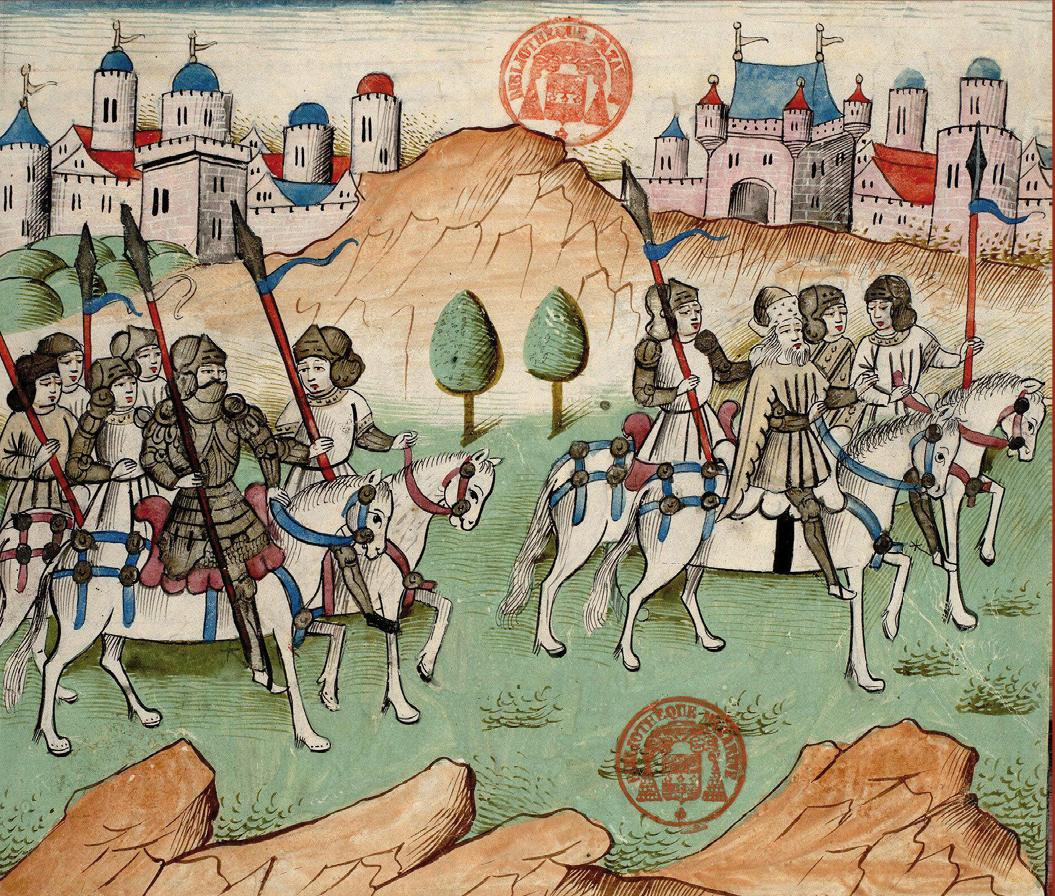
From the Historia Regum Britanniae to the European Bruts, part I : Towards a Typology of the vernacular adaptations of Geoffrey of Monmouth - Aberystwyth, Centre for Advanced Welsh and Celtic Studies, University of Wales, 15/16 June 2011. (Only en english)
The first symposium was hosted by the Centre for Advanced Welsh and Celtic Studies (CAWCS), on 15-16 June, 2011. The symposium was led by Hélène Tétrel and Géraldine Veysseyre, with the collaboration of Ceridwen Lloyd-Morgan, Heather Pagan, Paul Russel, Patrick Sims-Williams, and Brynley F. Roberts (see Appendix 1). Other participants included Erin Boon (Harvard University), Karen Jankulak (University of Wales, Trinity Saint David, Lampeter), Dafydd Johnston (CAWCS), Barry Lewis (CAWCS), Richard Glyn Roberts (University College, Dublin), Daniel Huws (National Library of Wales), Kelly Randell (University of Cambridge), and Owain Wyn Jones (University of Bangor).
The first day (June 15) was dedicated to a symposium on the European “Bruts”, with a special focus on the medieval Welsh adaptations in the morning, and a presentation of the Anglo-Norman, French and Icelandic adaptations in the afternoon (Appendix 1). Each session was followed by an extremely dense and long discussion in which all the participants took part. At the end of the day, every speaker was asked to hand in a written version of their presentation (approximately 8 pages, with a maximum of 10 pages), as well as a bibliography. A separate bibliography on the Welsh, Anglo-Norman, French and Old-Norse translations shall be made with the help of “zotero”, a software which makes it possible to quote the items according to different norms, especially the European and Harvard systems of bibliographical inventory. Both the papers of the symposium and the bibliography will be available throughout the duration of the HRBB project on the following website (the latter as a work in progress).
On the second day (June 16), a twofold workshop was dedicated to the development of a typology of the “Bruts” in Europe. In the morning, Géraldine Veysseyre made a presentation of the database “Jonas”. “Jonas” is a free, electronic device created ten years ago by Anne-Françoise Leurquin and Marie-Laure Savoye, who both work for the Department of Romance Languages at the Institut de Recherche et d’Histoire des Textes. First designed as an Access database and converted later to a MySQL language, “Jonas” was then made available online. It is, therefore, a very suitable tool for our purpose. It can be found at the URL: http://jonas.irht.cnrs.fr. The presentation was followed by a general discussion about the potential benefits of “Jonas” in working out an inventory of the manuscripts of the “Bruts”. Each participant was asked to hand in a codicological and palaeographical survey of their text to Géraldine Veysseyre and Hélène Tétrel, who shall share the task of storing our collective material in the database throughout the entire duration of the project. We hope to obtain the same kind of feedback from all the scholars taking part in the HRBB project.
In the afternoon, we focused on the textual aspects of the translations. The discussion was organized on the basis of a selection of relevant questions, with a view to working out a pattern to describe the content of the “Bruts” in Europe, to identify their sources and to describe the techniques used by each translator. Each participant added information relevant to their own linguistic area according to their own experience; thus, we were able to establish a series of common items to be pinpointed in the whole European tradition.
The result is to be synthesized in the form of a typological survey containing all relevant items, to be posted on the website (Appendix 2). The survey is designed to be downloaded and used by the participants of the “HRBB” network throughout the duration of the project.
Other proposals were made during this discussion regarding the textual tradition, such as developing comparative charts with personal names and place names, synchronisms, dedications and other key places of the translated texts.
Once we have gathered the relevant material on all representative versions of the “Bruts” in Europe, using all of the aforementioned devices (which are to be updated by permanent dialogue between scholars), we eventually hope to work out an inventory suitable for publication.
Symposium on the Bruts - Titles and Abstracts
Ceridwen Lloyd-Morgan (Formerly Head of Manuscripts & Visual Images, National Library of Wales)
“Elis Gruffydd and multiple versions of Geoffrey’s Historia” (PDF)
This paper focuses not on a single version closely based on the HRB but on a rather different model in terms of derivation and treatment, and a useful witness to a crucial period in the Brut tradition and to the re-evaluation of Geoffrey, in the 1540s-1550s. Elis Gruffydd (the ‘Soldier of Calais’fl. c. 1490-post 1552) wrote a vast Chronicle in Welsh in Calais, where he had been a member of the garrison since January 1530. In his Chronicle, which follows the traditional model of the Six Ages and ends with events of 1552, he draws on a staggering array of sources, relying heavily on Galfridian history for the relevant sections. The interest of this Chronicle within the context of the HRB’s legacy is two-fold. First, the plethora of versions used, including not only Geoffrey’s Latin text, but also versions in Anglo-Norman (Wace), English (La3amon; together with later histories indebted to Geoffrey, by, for example, Robert Fabian, Caxton and John Rastell) and perhaps the Welsh Brut y Brenhinedd. Secondly, Elis Gruffydd addresses the historicity of the HRB in direct response to contemporary debates.
Heather Pagan (Dr, Assistant Editor, Anglo-Norman Dictionary, Aberystwyth University)
“The Anglo-Normand Prose Brut — the Genesis of a National Chronicle” (PDF)
Defining the Anglo-Norman Prose Brut is a complicated business. The term is often used generically, but not always to refer to the same text. This talk will present the main texts in the family and discuss their sources, their composition and their evolution.
Brynley Roberts (Honorary Research Fellow, Centre for Advanced Welsh and Celtic Studies, Aberystwyth)
“A creative Welsh translator of Historia Regum Britanniae” (PDF)
Ystoriaeu brenhinedd ynys Brydein, found in the 14th century ms. BL Cotton Cleopatra Bv and the 15th century NLW 7006D, is the most thorough-going Welsh adaptation of Geoffrey’s Historia. The paper will examine the nature of this compiled text and its influence.
Paul Russell (Dr, Reader in Celtic,Cambridge)
“Translating Latin in early thirteenth-century Wales: some thoughts on the context of translating Geoffrey”
This paper explores the context in which the earliest translations of Geoffrey’s Historia Regum into Brut y Brenhinedd were made. Aspects which will be explored include the text's relationship with Dares Phrygius (also translated into Welsh as Ystorya Dared); the Welsh translation of the Life of Gruffudd ap Cynan; and the composition of Breudwyt Maxen Wledic ‘The Dream of Macsen Wledig’ (which Brynley Roberts has dated to the early thirteenth century in Gwynedd); and finally the nature and process of translating into Welsh.
Patrick Sims-Williams (Professor of Celtic Studies, Aberystwyth University)
“The Early Versions of Geoffrey in Welsh”
I will summarize some aspects of my work on the Welsh translations of Geoffrey, concentrating on the early versions (i.e. not the Red Book, Cleopatra, and Tysilio versions). In the title ‘early versions’ means translations found in 13c MSS (NLW Peniarth 44, NLW Llanstephan 1, NLW 5266) and also some versions only preserved in post-13c MSS (NLW Peniarth 21, 23, 24).
Hélène Tétrel (Maître de Conférences en langue et littérature médiévales françaises, Université de Bretagne Occidentale, Brest)
“Remarks on the two versions of the Old Norse translation of Geoffrey of Monmouth” (PDF)
In this presentation, I shall compare the version found in Hauksbók (Haukr’s book, 14th century) and the text of the second extensive version, manuscript AM 573 4to (14th century). Both go back to the same translation of Geoffrey, but differ sometimes from each other in an interesting way, either by suppressing or by adding materials.
Géraldine Veysseyre (Maître de Conférences en langue médiévale française, Université de Paris IV-Sorbonne/ Institut de Recherche et d’Histoire des Textes)
“The French prose translations of the Historia Regum Britanniae (from the 13th to the 15th centuries): origins, characteristics and medieval reception”
Even though its main topic is the British nation, Geoffrey of Monmouth’s chronicle was well known and widely disseminated on the Continent ? not just in Latin. The Historia Regum Britanniae became so famous, even among an audience who did not have easy access to texts in Latin, that quite a few French translations of this chronicle were commissioned.
Leaving aside the case of Wace’s Brut, as his translation in octosyllables cannot exactly be considered as “continental”, I would like to present a general overview of the French prose translations of Geoffrey. I shall compare them all according to:
their sources: do they mix Geoffrey’s chronicle with other authorities? What version of the Historia do they rely on?
their methods: did translators take as many liberties as Wace did, considering Geoffrey’s chronicle as a general pattern which deserved new ornaments? Or did they try their best to be accurate?
their reception: did they reach a large audience? (To answer this question, I shall rely mainly on the extant manuscripts of each of them). Did they circulate widely and meet with enduring success, or did they remain in a narrow circle?
Typological survey of the Bruts in Europe/FAQ:
NB: this survey can be used to describe any text you identify as a version of the “Brut”: either a text kept in a single manuscript as opposed to others in the same language, or a similar text contained in several affiliated manuscripts representing a similar version of the text.
1) The sources of your “Brut”: are they identifiable or not?
A) if a Latin source is identifiable: can your “Brut” be related to a type of Geoffrey’s manuscripts? (ex: Llanstephan 1 of the Middle Welsh Brut y Brenhinedd and all the witnesses of the Old Norse text are based on a “Vulgate/Saexburg” version; Wace’s Brut is based on the “First Variant Version”). Is the Latin source the direct model of your manuscript(s) or was there a vernacular intermediary?
B) if the direct source is vernacular: can you name and describe the intermediary(-ies)? (Some of the French prose Bruts, for example, have used Wace as an intermediary).
C) if mixed: can you say which part goes back to the Latin source and which to the vernacular? (some of the French prose Bruts, for example, compile a Vulgate version and Wace).
2) The editorial context: is your “Brut” an independent text or not?
A. if independent: is it whole or have (significantly large) parts of it been cut out? Where are the cuts? Please give the implicit and explicit if available. In case of material damage, feel free to point to several explanations/hypotheses regarding cuts and truncations.
B. if the “Brut” you deal with was used as an interpolation in a bigger compilation, please name/describe the compilation. Was the “Brut” inserted as a whole piece and then inserted, or was it cut into pieces for the pieces to be inserted in different places? Are there only selected sections of the “Brut” in the compilation? (For example, only the Arthurian part of Geoffrey’s text was used in the Middle Welsh chronicle of Elis Gruffydd). Please give the implicit and explicit of each section if available. In case of indecision because of material damages, feel free to point to several explanations/hypotheses regarding cuts and truncations.
C. was it used as a continuation and/or is it connected with a continuation?
3) The Prophetia Merlini: does it appear in your text?
A. if it does, is the translation, to the best of your knowledge, contemporaneous with the translation of the whole “Brut”? If not, please indicate the ways of transmission (for example, the Old Norse Merlinusspá was composed earlier than the extant manuscripts of the “Brut”, and inserted afterwards in one of them).
B. does anything remain of § 109-110 of the Historia?
C. if the Prophetia is not in your text, how does your text deal with its lack? (Many “Bruts”, for example, claim that the prophecy is already at hand, or that translating it would be too dangerous or too difficult a task to undertake).
4) The translator’s work:
(Please note: “translator” is an ambiguous category. Please adapt the word to your own topic, a unique text or a family of manuscripts, depending on the entity you wish to describe).
A. is your translation line-to-line? If it is, is it accurate or not? If it is inaccurate, are the innovations deliberate?
B. is your translation shortened, lengthened (more than the change of language would warrant)? Is it at times shortened and at times lengthened, depending on the parts the translator deals with? (Please indicate the parts of the texts showing specific treatment).
C. are there non-Galfridian (significantly large) episodes or comments within the text? If there are, can you say where the material comes from (Latin or vernacular sources)? (For example, some versions of the Brut y Brenhinedd have the tale of Llud ac Lleuelys; the Anglo-Norman Brut has the Lai de Havelok, etc.). Please indicate where exactly the episode is inserted and why (if you know). In case you cannot point to an identifiable source, do you have a hypothesis on the reason why the translator has inserted them?
D. how does the translator deal with prologues (including the description of Albio, § 6) and epilogues?
E. does the pattern of your “Brut” follow exactly the global feature of the Historia or are there structural changes (besides the changes that can be traced down to the use of a “First Variant Version” instead of a “Vulgate version”)?
F. how does the translator deal with historical time-frame, generally speaking? (E.g. are all the synchronisms kept exactly, are some left out, are there some new ones?). Is there another more visible chronological organization (e.g. greater weight given to the Universal chronology, more obvious division between the ages of Creation, etc.).
5) The associated texts:
Please note: by “associated texts” we mean texts that are kept together (for example, a compilation) in the same manuscript or in a group of related manuscripts, but are not attached to the Brut, interpolated in it or interlaced with it. The concept might not be relevant to all “Bruts”.
A) is there a translation of the Trojan cycle (Pseudo-Dares and associated sources)?
B) is there a translation of other late antique texts? Which ones?
C) is there a translation of other prophecies outside the “Brut”? (e.g. Prophecy of the Eagle, etc.).
D) is there another/other vernacular text(s) which have a relation with the “Brut”? (e.g. national chronicle, etc.).
6) Any other item related to the textual content: (e.g. is there an iconographical programme, are there marginal glosses in keeping with the text of a given book? Etc.)



